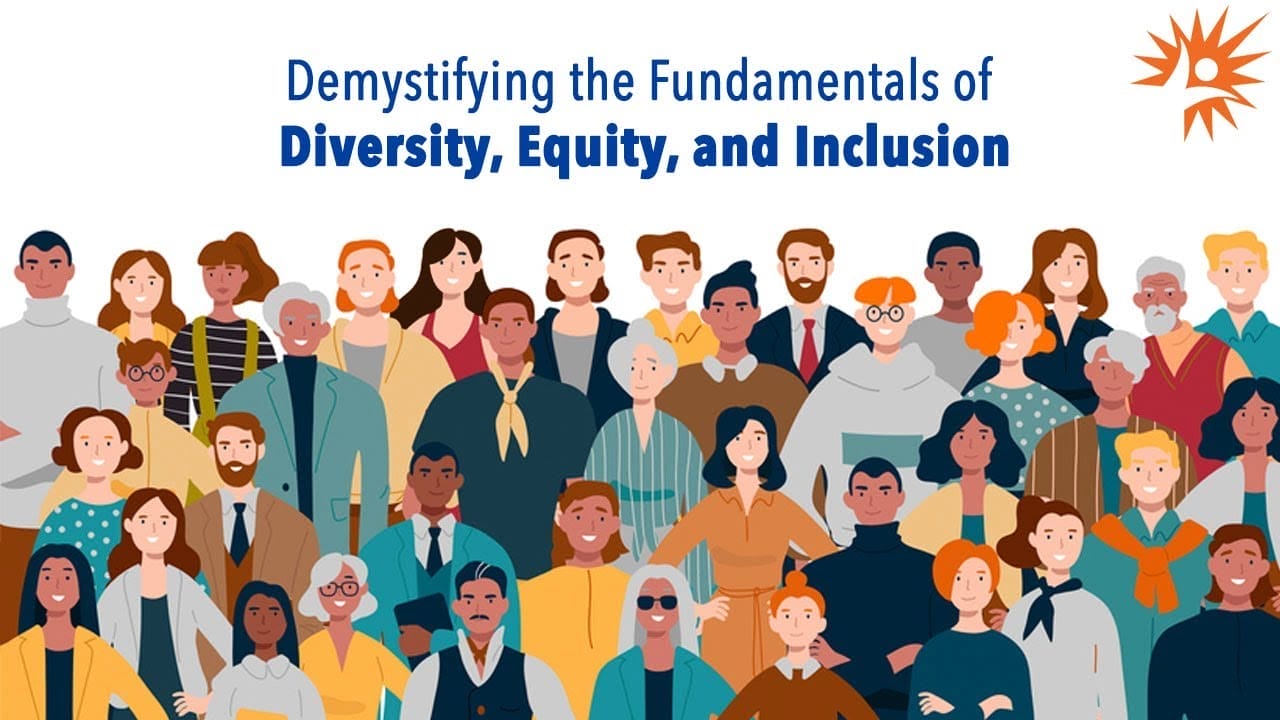Did you know that 45% of L&D professionals planned to deploy diversity, equity, and inclusion (DEI) programs in 2022? This is a significant increase from 34% in 2021, highlighting the growing recognition of the importance of DEI training in creating diverse and inclusive workplaces.
DEI training goes beyond merely ticking boxes or meeting compliance requirements. It aims to create work environments where every individual feels valued, respected, and empowered to contribute their unique perspectives and experiences. By equipping employees with the knowledge, skills, and tools necessary for fostering diversity and inclusion, organizations can build stronger teams and drive positive change.
Key Takeaways:
- DEI training is crucial for creating diverse and inclusive work environments.
- It involves equipping employees with knowledge, skills, and tools for fostering diversity and inclusion.
- DEI training topics may include unconscious bias, cultural competence, LGBTQ+ inclusion, and equal opportunity.
- Effective DEI training improves workplace culture, employee morale, and business outcomes.
- Companies can measure the effectiveness of DEI training through surveys, feedback, and data analysis.
The Meaning of DEI Training
DEI training, or Diversity, Equity, and Inclusion training, is an essential process used by organizations to promote diversity, equity, and inclusion in the workplace. It serves as a catalyst for cultivating a harmonious and equitable work environment where every individual feels valued and included. By addressing issues of bias, discrimination, and underrepresentation, DEI training aims to foster a culture that celebrates diversity and offers equal opportunities for all employees.
This type of training goes beyond mere awareness and acknowledgement of diversity. It involves activities, initiatives, and brochures that raise awareness, educate employees on best practices, and provide resources to build inclusive workplaces. DEI training programs encompass a wide range of topics, such as diversity training, inclusion training programs, and best practices, to equip employees with the knowledge and skills necessary for fostering an inclusive workplace.
Companies invest in DEI training because they understand the numerous benefits it brings. By promoting diversity and inclusion, organizations create an environment where employees from diverse backgrounds can thrive and contribute their unique perspectives. This, in turn, leads to increased innovation, employee satisfaction, and improved business outcomes.
DEI training is an ongoing initiative that requires commitment and the implementation of systematic changes in the workplace. It involves creating a culture of inclusivity, eradicating biases, fostering respect and appreciation, and building a sense of belonging among all employees.
| Diversity Training | Inclusion Training Programs | Best Practices |
|---|---|---|
| Raises awareness about the importance of diversity | Equips employees with the skills to create inclusive environments | Provides guidance on implementing effective diversity and inclusion strategies |
| Explores unconscious biases and their impact on decision-making | Promotes understanding and respect for different cultures, backgrounds, and perspectives | Encourages ongoing learning and development to stay up-to-date with current best practices |
| Addresses issues of discrimination and underrepresentation | Advocates for equal opportunities and fair treatment for all employees | Empowers employees to be advocates for diversity and inclusion in their roles |
By incorporating diversity training, inclusion training programs, and best practices into their organizational strategies, companies create an environment where everyone feels valued, respected, and equipped to contribute their best.
Refer to this comprehensive guide on Diversity, Equity, and Inclusion to learn more about different strategies and resources available for DEI training.
Key Components of DEI Training
When it comes to diversity, equity, and inclusion (DEI) training, it is crucial to cover a wide range of topics to ensure comprehensive training and awareness. DEI training programs typically include the following key components:
- Unconscious Bias Training: This component focuses on raising awareness about unconscious biases that may influence decision-making and behavior. It helps participants recognize their biases and develop strategies to mitigate their impact.
- Cultural Competence: Cultural competence training aims to enhance understanding and appreciation of different cultures and customs. It provides individuals with the knowledge and skills needed to effectively collaborate and communicate in diverse environments.
- LGBTQ+ Inclusion: LGBTQ+ inclusion training creates a safe and welcoming environment for LGBTQ+ employees. It educates participants about LGBTQ+ identities, experiences, and challenges, fostering an inclusive workplace for all.
- Equal Opportunity: This component of DEI training focuses on promoting equal opportunity and eliminating discrimination in the workplace. It addresses issues like equal pay, fair hiring practices, and creating a work environment free from harassment and bias.
These key components work together to create a comprehensive and effective DEI training program. By addressing various aspects of diversity and inclusion, organizations can foster a safe and welcoming environment for employees of all backgrounds.
DEI training programs often incorporate diverse teaching methods to engage participants and maximize learning outcomes. Workshops, training modules, and interactive activities are commonly used to encourage active participation and understanding.
Workshops provide opportunities for participants to actively engage with the training material through group discussions, case studies, and role-playing exercises. They enable participants to share their experiences, learn from others, and develop practical strategies for promoting diversity and inclusion in the workplace.
Training modules are structured learning materials that cover specific DEI topics in a comprehensive manner. These modules may include multimedia content, such as videos, quizzes, and interactive exercises, to enhance participant engagement and retention of knowledge.
By incorporating diverse teaching methods, DEI training programs create an inclusive learning environment that caters to various learning styles and preferences.
Benefits of Key Components
Each key component of DEI training brings unique benefits to both employees and organizations. Unconscious bias training helps individuals recognize and overcome biases, leading to fairer decision-making processes and improved workplace relationships.
Cultural competence training fosters understanding and respect for different cultures, resulting in more effective collaboration and communication across diverse teams.
LGBTQ+ inclusion training creates a safe and supportive environment for LGBTQ+ employees, promoting their overall well-being and productivity.
Equal opportunity training ensures that all employees have equitable access to professional growth and advancement opportunities, contributing to a more diverse and inclusive workforce.
By investing in DEI training that encompasses these key components, organizations can reap the benefits of a more diverse and inclusive workplace, such as increased innovation, employee satisfaction, and business success.
| Key Components of DEI Training | Benefits |
|---|---|
| Unconscious Bias Training | Awareness of biases, fair decision-making, improved workplace relationships |
| Cultural Competence | Effective collaboration, better communication, respect for diverse cultures |
| LGBTQ+ Inclusion | Safe and supportive environment, employee well-being, increased productivity |
| Equal Opportunity | Equitable access to opportunities, diverse workforce, improved business outcomes |
Measuring the Effectiveness of DEI Training
Assessing the impact of diversity and inclusion training is essential for organizations to determine its effectiveness. Various methods can be employed to measure the outcomes and monitor progress. These include:
- Surveys: Conducting surveys allows companies to gather feedback from employees regarding their attitudes and behaviors. By asking targeted questions related to diversity and inclusion, organizations can gauge the effectiveness of the training and identify areas for improvement.
- Data Analysis: Analyzing data related to workplace culture, such as employee satisfaction and retention rates, can provide valuable insights into the impact of DEI training. Companies can track changes over time and assess whether the training has had a positive effect on these metrics.
- Feedback: Encouraging employees to provide feedback on the training can offer valuable insights. By soliciting input through focus groups, interviews, or anonymous suggestions, organizations can gain a better understanding of how the training has influenced employee behavior and attitudes.
Ultimately, the goal of measuring the effectiveness of DEI training is to identify strengths and areas for improvement. This data-driven approach enables organizations to make informed decisions and adaptations to ensure the training meets its intended objectives.
Example survey questions for measuring the effectiveness of diversity and inclusion training:
- Has the diversity and inclusion training increased your awareness of unconscious bias in the workplace?
- Do you feel more equipped to identify and address instances of bias or discrimination?
- Have you noticed positive changes in the workplace culture since participating in the training?
- Do you believe the training has improved your ability to work effectively with colleagues from diverse backgrounds?
- Has the training influenced your views on creating a more inclusive work environment?
Tracking Metrics for Measuring DEI Training Effectiveness:
| Metric | Description |
|---|---|
| Employee Satisfaction | Measure of overall job satisfaction and sense of inclusion among employees |
| Workplace Culture | Evaluated through surveys and employee feedback, assessing the level of diversity, inclusivity, and equity in the company |
| Diversity of Applicants | Tracking changes in the diversity of applicants can indicate the effectiveness of DEI training in attracting a more diverse candidate pool |
| Retention Rates | Tracking the retention rates of employees from underrepresented groups can demonstrate the impact of DEI training on the organization’s ability to retain diverse talent |
By utilizing these measurement methods and tracking relevant metrics, organizations can gain valuable insights into the impact of their diversity and inclusion seminars and unconscious bias training. This data-driven approach enables informed decision-making and the ongoing improvement of DEI training efforts.
Challenges in DEI Training

While implementing diversity and inclusion best practices through cultural competency training is essential, organizations may encounter various challenges along the way. These hurdles can include resistance from employees, a lack of buy-in from leadership, and limited resources. However, it’s crucial for organizations to address these challenges effectively to ensure the success of their DEI initiatives.
Fostering a culture of inclusivity is key to overcoming resistance and creating an environment where diversity and inclusion can thrive. Organizations should strive to provide ongoing support and resources to ensure that DEI training is embedded into the fabric of the workplace. By doing so, they can foster an atmosphere where discussions about diversity and inclusion are safe and open.
Creating a safe and open environment for discussion, providing ongoing training and development opportunities, and holding leaders accountable for fostering inclusivity are some of the best practices for overcoming challenges in DEI training.
Organizations should actively encourage employees to engage in conversations surrounding diversity and inclusion. Ongoing training and development opportunities can help foster cultural competency and equip employees with the necessary tools to challenge biases and promote inclusivity. In addition, leaders must be held accountable for creating an inclusive environment and championing diversity throughout the organization.
By addressing these challenges head-on and implementing best practices, organizations can build a stronger foundation for diversity and inclusion, leading to a more equitable and diverse workplace.
The Importance of a Safe and Open Environment
A safe and open environment fosters honest discussions about diversity and inclusion. It allows employees to share their experiences and perspectives without fear of judgment or retribution. This encourages empathy, understanding, and collaboration among team members, leading to a more inclusive workplace.
Providing Ongoing Training and Development Opportunities
DEI training should not be a one-time event. To create lasting change, organizations should provide continuous learning opportunities to reinforce knowledge and skills related to diversity and inclusion. This can include workshops, seminars, and online resources that help employees develop cultural competency and identify and address unconscious biases.
Holding Leaders Accountable
Leaders play a crucial role in promoting diversity and inclusion within an organization. Holding leaders accountable for fostering inclusivity sends a clear message that diversity is a priority. It encourages them to lead by example and take active measures to ensure that policies, practices, and behaviors align with the organization’s diversity and inclusion goals.
The Future of DEI Training
As organizations recognize the importance of diversity and inclusion, DEI training is becoming an evolving field that plays a vital role in shaping the future of workplaces.
The future of DEI training lies in integrating it into all aspects of an organization’s culture and operations, creating a holistic approach to fostering diversity, equity, inclusion, and accessibility (DEIA).
Embedding DEIA in Organizational Processes
Companies should strive to embed DEIA practices into their hiring processes, leadership development programs, and employee engagement initiatives. By doing so, they can ensure that DEIA is not an isolated training program but a fundamental part of the organizational DNA. This integration facilitates long-term behavior change and sustains a diverse and inclusive work environment.
Utilizing Technology for DEI Training
Technology, such as online learning platforms, can help expand access to DEI training and provide ongoing support and resources. Virtual training programs and interactive modules enable employees to engage with DEIA content at their own pace and convenience. This approach allows organizations to reach a broader audience and accommodate diverse learning styles and preferences.
Fostering Continuous Learning and Improvement
DEI training should not be a one-time event but an ongoing journey of learning and improvement. Organizations should encourage continuous education and provide avenues for employees to expand their knowledge and skills in DEIA. This can be achieved through workshops, seminars, conferences, and mentorship programs that promote deep learning and meaningful exchanges of ideas.
Collaborating with External Experts
Engaging with external diversity and inclusion experts can bring fresh perspectives and insights to DEI training initiatives. These experts can provide guidance and support in developing robust training content, tailoring it to the organization’s specific needs, and ensuring that it aligns with industry best practices and current trends.
Overall, the future of DEI training is bright, with organizations recognizing the need to create diverse, inclusive, and equitable workplaces. By integrating DEIA into all aspects of their operations and utilizing technology for enhanced accessibility, organizations can drive meaningful change and create environments where every individual feels valued and heard.
Examples of DEI Training Programs

When it comes to DEI training, organizations have a wide range of programs to choose from. These programs offer valuable insights and resources for promoting diversity and inclusion in the workplace. Here are some examples:
- Karamo’s Diversity, Equity, and Inclusion Training
- Equal Employment Opportunity
- Diversity and Inclusion
- How to be a Team Player
- Diversity and Inclusion in Retail
Each of these programs covers a variety of topics related to DEI training, providing participants with the knowledge and skills needed to foster a diverse and inclusive work environment. By implementing these programs, organizations can empower their employees to create positive change and drive meaningful inclusion.
Whether it’s through workshops, seminars, or online modules, DEI training programs offer practical tools and strategies for addressing bias, promoting cultural competency, and ensuring equal opportunities for all. They play a crucial role in building awareness, empathy, and understanding among employees and ultimately contribute to a more inclusive and harmonious workplace.
“Diversity is not about how we differ. Diversity is about embracing one another’s uniqueness.” – Ola Joseph
By investing in DEI training programs, organizations can make a significant impact on their workplace culture, employee engagement, and overall business success. These programs provide essential guidance and resources for navigating the complexities of diversity and inclusion, helping companies create environments where every individual feels valued, heard, and empowered to thrive.
| Program | Description |
|---|---|
| Karamo’s Diversity, Equity, and Inclusion Training | A comprehensive program that covers a wide range of DEI topics, including unconscious bias, cultural competence, and LGBTQ+ inclusion. |
| Equal Employment Opportunity | Focused on promoting equal opportunities and preventing discrimination in the workplace, this program helps organizations navigate legal requirements and create inclusive policies. |
| Diversity and Inclusion | A program that explores the value of diversity and inclusion, providing participants with the knowledge and tools to foster an inclusive work environment. |
| How to be a Team Player | This program emphasizes the importance of teamwork and collaboration, highlighting how diverse teams can bring different perspectives and drive innovation. |
| Diversity and Inclusion in Retail | Specifically tailored for the retail industry, this program addresses topics such as customer diversity, cultural sensitivity, and inclusive customer service. |
Importance of DEI Training Topics
DEI training covers a range of topics that are crucial for fostering a diverse and inclusive workplace. Each topic plays a unique role in raising awareness, promoting understanding, and creating a safe and welcoming environment for all employees.
Unconscious Bias Training
One important DEIA training topic is unconscious bias training. This type of training helps individuals identify and mitigate biases that impact their decision-making and interactions with others. By increasing awareness of unconscious biases, employees can make more informed and inclusive decisions in the workplace.
Cultural Competence
Another key topic in DEIA training is cultural competence. This training aims to promote understanding and appreciation of different cultures and customs. It helps employees develop the skills needed to navigate diverse workplaces, communicate effectively with colleagues from various backgrounds, and respect cultural differences.
LGBTQ+ Inclusion Training
DEIA training also includes LGBTQ+ inclusion training, which ensures a safe and welcoming environment for all employees. This training helps organizations create a workplace culture that embraces and supports LGBTQ+ individuals, fostering inclusivity and eliminating discrimination based on sexual orientation or gender identity.
Equal Opportunity and Affirmative Action Training
Equal opportunity and affirmative action training is another vital component of DEIA training. This training provides employees with a clear understanding of fair employment practices, including the importance of equal opportunities for all individuals, regardless of their race, gender, or other protected characteristics.
By addressing these critical DEIA training topics, organizations can cultivate an environment that values diversity, promotes inclusion, and ensures equal opportunities for all employees.
| DEI Training Topics | Description |
|---|---|
| Unconscious Bias Training | Identify and mitigate biases that impact decision-making and interactions. |
| Cultural Competence | Promote understanding and appreciation of different cultures and customs. |
| LGBTQ+ Inclusion Training | Create a safe and welcoming environment for LGBTQ+ employees. |
| Equal Opportunity and Affirmative Action Training | Promote fair employment practices and equal opportunities. |
Source: Forbes: The Importance of Diversity and Inclusion Training
Benefits of DEI Training

DEI training offers significant benefits to both employees and organizations. By fostering a diverse and inclusive workplace, DEI training creates a positive environment that encourages personal and professional growth, improves communication and teamwork, and enhances workplace culture. Let’s explore the specific benefits:
1. Increased Awareness and Empathy
DEI training equips employees with essential knowledge and understanding to navigate the complexities of working in a diverse environment. Through education and awareness-building activities, employees develop a deeper understanding of different perspectives, experiences, and challenges, cultivating empathy and inclusivity within the workplace.
2. Personal and Professional Growth
Participating in DEI training provides employees with valuable opportunities for personal and professional growth. It allows individuals to reflect on their own biases, develop cultural competence, and expand their perspective, leading to enhanced critical thinking skills and decision-making abilities.
3. Improved Communication and Teamwork
DEI training fosters effective communication and collaboration among team members from diverse backgrounds. It cultivates a culture of respect, open dialogue, and active listening, enabling teams to leverage a wide range of perspectives and ideas, leading to more innovative and inclusive solutions.
4. Enhanced Workplace Culture
DEI training plays a vital role in creating a positive and inclusive workplace culture. By addressing biases, promoting equal opportunities, and fostering respect, organizations can cultivate an environment where everyone feels valued, respected, and able to contribute their best work. A positive workplace culture also leads to higher employee morale and satisfaction.
5. Improved Business Outcomes
Organizations that prioritize DEI training often experience improved business outcomes. A diverse and inclusive workforce brings together a wider range of skills, experiences, and perspectives, leading to enhanced problem-solving, decision-making, and creativity. It also helps attract top talent, boosts employee retention, and promotes a positive reputation both internally and externally.
6. An Enhanced Reputation
DEI training demonstrates an organization’s commitment to fostering a diverse and inclusive environment. By investing in DEI training programs, organizations can build a reputation as an employer of choice, attracting a diverse pool of talent and fostering positive relationships with clients, customers, and partners.
Overall, DEI training offers a multitude of benefits that positively impact both individual employees and the organization as a whole. By embracing diversity and promoting inclusivity, organizations can create a harmonious and empowering work environment that drives success and meaningful change.
| Benefits of DEI Training |
|---|
| Increased awareness and empathy |
| Personal and professional growth |
| Improved communication and teamwork |
| Enhanced workplace culture |
| Improved business outcomes |
| An enhanced reputation |
Checking Out DEI Training Programs
When it comes to implementing effective DEI training programs, organizations have several options to explore. These programs offer valuable resources and insights for organizations looking to promote diversity and inclusion in their workplace.
One notable example is Karamo’s Diversity, Equity, and Inclusion Training. This program focuses on providing comprehensive training modules that address various aspects of diversity and inclusion, empowering employees to create inclusive work environments.
Another program worth considering is Equal Employment Opportunity, Diversity and Inclusion. This training emphasizes the importance of equal opportunity and fairness in the workplace, educating employees on the benefits of diversity and the challenges of bias and discrimination.
If you’re looking for a program that focuses on building collaborative teams, How to be a Team Player can be a great choice. This training equips employees with the necessary skills and knowledge to work effectively in diverse teams, fostering collaboration and mutual respect.
For organizations in the retail industry, Diversity and Inclusion in Retail offers specialized training on addressing the unique challenges faced by frontline retail employees. This program provides insights and strategies to create an inclusive environment for both customers and employees.
These are just a few examples of the diverse range of DEI training programs available. Each program offers unique insights and resources to support organizations in their journey towards creating diverse, equitable, and inclusive workplaces.
| DEI Training Program | Description |
|---|---|
| Karamo’s Diversity, Equity, and Inclusion Training | Comprehensive training modules addressing various aspects of diversity and inclusion. |
| Equal Employment Opportunity, Diversity and Inclusion | Focusing on equal opportunity, fairness, and the challenges of bias and discrimination. |
| How to be a Team Player | Building collaborative teams through effective communication and respect for diversity. |
| Diversity and Inclusion in Retail | Addressing unique challenges faced by frontline retail employees in creating an inclusive environment. |
Conclusion
DEI training plays a crucial role in creating diverse, inclusive, and equitable work environments. By addressing issues of bias, discrimination, and underrepresentation, organizations can foster a culture of inclusivity and equal opportunity. Through comprehensive DEI training programs, employees gain the knowledge, skills, and tools necessary to navigate the complexities of a diverse workplace.
Implementing DEI training not only improves workplace culture but also enhances employee morale and drives positive business outcomes. By cultivating an environment that values diversity and inclusion, organizations can attract and retain top talent, foster innovation, and strengthen relationships with customers and stakeholders.
Hyperspace offers tailored DEI training solutions to help organizations achieve their diversity and inclusion goals efficiently and effectively. With our expertise and resources, organizations can create a workplace where every individual feels valued, respected, and empowered to contribute their unique perspectives and talents.
FAQ
What is diversity and inclusion (DEI) training?
DEI training aims to create diverse, inclusive, and equitable work environments by giving employees the knowledge, skills, and tools necessary for fostering diversity and inclusion.
What topics are covered in DEI training programs?
DEI training programs cover a range of topics, including unconscious bias, cultural competence, LGBTQ+ inclusion, equal opportunity, and more.
How does DEI training benefit organizations?
DEI training improves workplace culture, employee morale, and business outcomes by creating equitable and harmonious work environments.
How is the effectiveness of DEI training measured?
The effectiveness of DEI training can be measured through surveys, feedback, data analysis, and by tracking changes in workplace culture, diversity of applicants, and employee satisfaction.
What are the challenges in DEI training?
Challenges in DEI training include resistance from employees, lack of buy-in from leadership, and limited resources. However, best practices such as fostering a safe and open environment for discussion, providing ongoing training and development opportunities, and holding leaders accountable for inclusivity can help overcome these challenges.
What is the future of DEI training?
The future of DEI training lies in integrating it into all aspects of an organization’s culture and operations, embedding diversity and inclusion practices in hiring processes, leadership development, and employee engagement initiatives. Technology, such as online learning platforms, can also expand access to DEI training and provide ongoing support and resources.
Can you provide examples of DEI training programs?
Some examples of DEI training programs include Karamo’s Diversity, Equity, and Inclusion Training, Equal Employment Opportunity, Diversity and Inclusion, How to be a Team Player, and Diversity and Inclusion in Retail. These programs offer valuable insights and resources for promoting diversity and inclusion in the workplace.
What are the key components of DEI training?
DEI training covers a range of topics to ensure comprehensive training and awareness. Key components may include unconscious bias training, cultural competence, LGBTQ+ inclusion, equal opportunity, and more.
How does DEI training benefit both employees and organizations?
DEI training benefits employees by making them more aware, empathetic, and equipped to navigate the complexities of a diverse workplace. It fosters personal and professional growth, improves communication and teamwork, and enhances workplace culture. Organizations benefit from a more equitable and harmonious work environment, improved business outcomes, and an enhanced reputation.
Where can organizations find DEI training programs?
There are several DEI training programs available to organizations. Some examples include Karamo’s Diversity, Equity, and Inclusion Training, Equal Employment Opportunity, Diversity and Inclusion, How to be a Team Player, and Diversity and Inclusion in Retail. These programs offer valuable resources and insights for organizations looking to promote diversity and inclusion in their workplace.
What are the important DEI training topics?
Each DEI training topic plays a crucial role in fostering a diverse and inclusive workplace. Unconscious bias training helps identify and mitigate biases, cultural competence promotes understanding and appreciation of different cultures, LGBTQ+ inclusion training ensures a safe and welcoming environment, and equal opportunity and affirmative action training is vital for fair employment practices.





